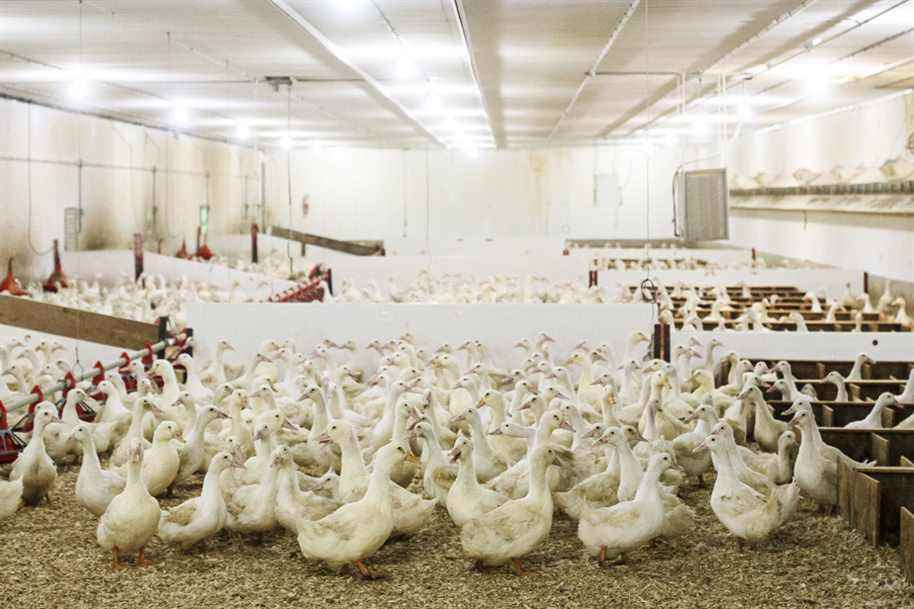The discovery of an outbreak of highly pathogenic H5N1 avian influenza in the Canards du Lac Brome facilities in the Eastern Townships has Quebec poultry producers on their toes. While large breeders under supply management advocate tighter controls, small outdoor farms fear becoming scapegoats.
Posted at 12:00 a.m.
“The worry is at its peak. There are producers who asked for psychological help, ”testified the president of the Poultry Breeders of Quebec, Pierre-Luc Leblanc, in a telephone interview Thursday.
This is the first time that a commercial farm has been hit by an avian flu epidemic in Quebec.
And this strain of H5N1, which has caused hundreds of outbreaks on four continents, isn’t called “highly pathogenic” for nothing. When a herd is affected, “more than 90% will fall ill, and mortality could reach almost 100%”, underlines the Dr Jean-Pierre Vaillancourt, professor at the Faculty of Veterinary Medicine at the University of Montreal.
Letting the birds die of the flu is “not a win-win from an animal welfare point of view”, so infected flocks like at Canards du Lac Brome are instead euthanized under the supervision of the Canadian Food Inspection Agency ( CFIA).
The company, which produces more than 2 million ducks a year, confirmed an outbreak at its Saint-Claude site in a press release on Wednesday, but declined to comment. The CFIA confirmed another case in a commercial farm in the MRC of Brome-Missisquoi on Thursday, but at the start of the evening, Canards du Lac Brome had still not indicated whether it was indeed its Knowlton site. she had quarantined “as a precaution”. The Quebec Poultry Disease Control Team (EQCMA) has also drawn an “enhanced biosecurity zone in emergency situations” around Knowlton, recommending that the entire poultry industry avoid driving there. Another case was also confirmed in a small non-commercial farm.

PHOTO ELENA MARSOLAIS, PROVIDED BY UPA
Pierre-Luc Leblanc, President of Poultry Breeders of Quebec
“It’s a drama and an incredible financial stress to see your birds die,” said Mr. Leblanc, who asked his members to reinforce the application of existing biosecurity measures (change of boots and clothes, disinfection, etc.).
Laboratory closed for Easter
While new outbreaks are added in the province, the laboratory of the Ministry of Agriculture, Fisheries and Food of Quebec (MAPAQ), where the suspect samples are analyzed, is closed for the long Easter holiday, from Friday to Tuesday, learned The Press.
“The analyzes will be carried out by the CFIA laboratory in Winnipeg,” the ministry confirmed by email Thursday evening.
“I am simply stunned! “, commented the Dr Vaillancourt. “Controlling this virus is a question of reaction time” and sending the samples to Manitoba “possibly adds a day” before we have the result. “As long as we do not have confirmation, there are several things that do not fall into place,” he underlines. If the flock is indeed infected, “we have birds that are dying for one more day”.
No ride on Sunday
The president of Poultry Breeders asks for his part to avoid visits to the farm during the Easter holiday.
“People in the city, it’s not the time to go for a Sunday walk and walk in the countryside,” said Mr. Leblanc, recalling that the virus can be transported by vehicle tires.
In cool weather, in untreated water containing organic matter, this virus is very resistant, specifies the Dr Vaillancourt. “I have just described to you all the ponds in Quebec right now…”
Current models indicate that the probability of contamination will be high at least until mid-June, notes the veterinarian.
In this context, agrotourism, “until the end of June, is not a good idea. Then we’ll see how it goes.”
Poultry Breeders, a federation of the Union of Agricultural Producers (UPA), says it is aware that consumers like to get their supplies from the farm and that Quebec wants to encourage food self-sufficiency. But “with avian flu, having birds outside in contact with migratory birds may not be the right solution,” says Mr. Leblanc, who says he is “in discussion” with MAPAQ.
The Ministry has already intervened “in times of crisis” to request the confinement of the birds, he argues. “We got there, saying, ‘What are we doing to protect ourselves?’ »
At the Cooperative for Ecological Local Agriculture (CAPE), which brings together more than 200 farms, of which about 80 have poultry production (eggs, chickens, turkeys), it is recalled that members must already apply existing biosanitary measures, including limiting poultry interactions with wild animals, and ensuring there is no contamination of water or food.

PHOTO PROVIDED BY LÉON BIBEAU-MERCIER
Léon Bibeau-Mercier, secretary of the Cooperative for ecological local agriculture
“Our concern is that open-air breeders are potentially scapegoats in this story,” explains CAPE secretary Léon Bibeau-Mercier, recalling that the reality of open-air or small-scale farming is poorly documented. Would imposing indoor confinement or an open-air mesh roof really reduce the risk, or would it only be imposed as a precautionary measure? he wonders. The possibility of such tightening, “it is sure that it is an additional layer of concern for our farms”.
The MAPAQ did not impose additional measures on Thursday, but reiterated several recommendations to avoid any contact between wild and farmed birds (put a net on the outdoor enclosures, limit access to the farm to authorized people, clean and disinfect motor vehicles before they enter breeding grounds, etc.).
Low risk for humans
- Transmission of H5N1 avian influenza to humans is rare
- Usually by prolonged contact with infected birds in an enclosed area
- No indications of transmission through properly prepared meat or eggs
- No human cases of this H5N1 strain in Canada
Sources: Quebec Ministry of Agriculture, Fisheries and Food, Canadian Food Inspection Agency
Learn more
-
- 3
- Number of Quebec poultry farms infected with H5N1 avian influenza detected in less than two days
Source: Canadian Food Inspection Agency

